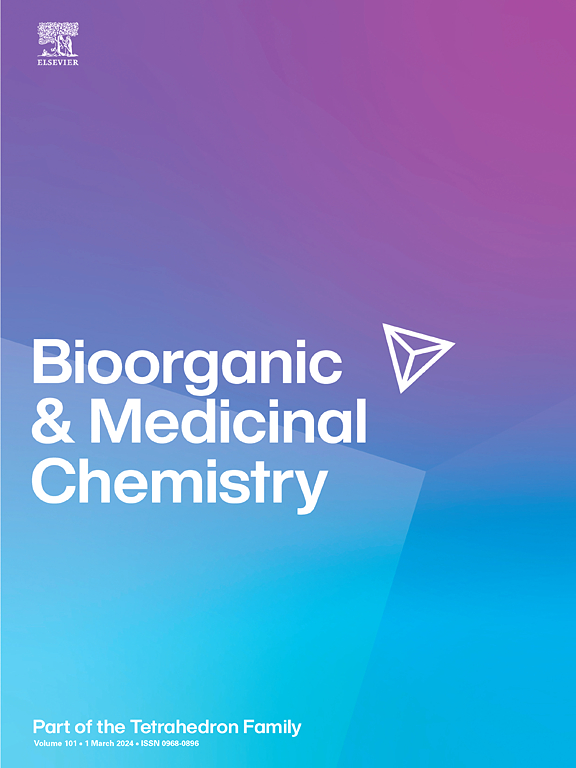(R)-罗斯科维汀衍生物(R)-6-[N-(3-(4-氯苯基)丙基]通过抑制细胞周期蛋白依赖性激酶抑制肺癌进展
IF 3
3区 医学
Q2 BIOCHEMISTRY & MOLECULAR BIOLOGY
引用次数: 0
摘要
细胞周期蛋白依赖性激酶(CDKs)是细胞周期检查点的关键调节因子,能够磷酸化蛋白质,从而控制基本的细胞功能,如分化、增殖和凋亡。尽管各种CDK抑制剂(CDKIs),包括(R)-罗斯科维汀,也被称为seliciclib,在临床前模型中显示出有希望的结果,但它们的临床转化受到限制。本研究旨在设计和合成具有较好药理特性的(R)-罗斯科维汀衍生物。一系列化合物(4a-4q)被合成,结构验证和评估对癌细胞的作用,包括肺癌(A549),三阴性乳腺癌(MDA-MB-231),恶性黑色素瘤(A375)细胞和正常人上皮细胞(BEAS-2B)和胚胎肺成纤维细胞(MRC-5)细胞。此外,该化合物被评估其对多种CDKs的抑制潜力。其中,(R)-6-[N-(3-(4-氯苯基)丙基)]类似物(4 g)对CDK2和CDK13的抑制作用最高,对A549细胞的抗增殖活性(IC50 = 0.61±0.06 μM)高于(R)-罗斯科维汀(13.30±1.05 μM)。化合物4 g在BEAS-2B和MRC-5细胞中的IC50值分别为1.437±0.17 μM和1.280±0.37 μM,是A549细胞IC50值的2 ~ 2.35倍。化合物4 g显著(p <;0.0001)诱导s期细胞周期阻滞,抑制A549细胞的迁移和侵袭。硅对接研究表明,与CDK13具有强而稳定的相互作用,结合亲和力为−8.0 kcal/mol。化合物4g显示出良好的抗癌潜力,可能是由CDK抑制介导的,对正常细胞的毒性相对较低,但需要进一步的毒理学评估和临床前研究。本文章由计算机程序翻译,如有差异,请以英文原文为准。
![(R)-6-[N-(3-(4-chlorophenyl) propyl] derivative of (R)-roscovitine inhibits lung carcinoma progression via cyclin-dependent kinase suppression](https://img.booksci.cn/booksciimg/2025-7/102305737551784189573.jpg)
(R)-6-[N-(3-(4-chlorophenyl) propyl] derivative of (R)-roscovitine inhibits lung carcinoma progression via cyclin-dependent kinase suppression
Cyclin-dependent kinases (CDKs) are crucial regulators of cell cycle checkpoints, capable of phosphorylating proteins and thereby governing essential cellular functions such as differentiation, proliferation, and apoptosis. Although various CDK inhibitors (CDKIs), including (R)-roscovitine, also known as seliciclib, have demonstrated promising outcomes in preclinical models, their clinical translation has been limited. This study aimed to design and synthesize (R)-roscovitine derivatives with improved pharmacological profiles. A series of compounds (4a–4q) was synthesized, structurally validated and evaluated against cancerous cells, including lung carcinoma (A549), triple-negative breast cancer (MDA-MB-231), and malignant melanoma (A375) cells and normal human epithelial (BEAS-2B) and embryonic lung fibroblasts (MRC-5) cells. Furthermore, the compound was assessed for its inhibitory potential against a broad panel of CDKs. Among these, the (R)-6-[N-(3-(4-chlorophenyl) propyl)] analogue (4 g) showed the highest inhibition of CDK2 and CDK13, along with potent antiproliferative activity (IC50 = 0.61 ± 0.06 μM) against A549 cells compared to (R)-roscovitine (13.30 ± 1.05 μM). Similarly, Compound 4 g showed an IC50 value of 1.437 ± 0.17 μM and 1.280 ± 0.37 μM in BEAS-2B and MRC-5 cells, which is 2 to 2.35 folds of the IC50 value in A549 cells. Compound 4 g significantly (p < 0.0001) induced S-phase cell cycle arrest and suppressed cellular migration and invasion of A549 cells. In silico docking studies revealed a strong and stable interaction with CDK13, with a binding affinity of −8.0 kcal/mol. Compound 4 g demonstrates promising anticancer potential, likely mediated by CDK inhibition with comparatively lower toxicity toward normal cells, however, it requires further toxicological assessment and preclinical studies.
求助全文
通过发布文献求助,成功后即可免费获取论文全文。
去求助
来源期刊

Bioorganic & Medicinal Chemistry
医学-生化与分子生物学
CiteScore
6.80
自引率
2.90%
发文量
413
审稿时长
17 days
期刊介绍:
Bioorganic & Medicinal Chemistry provides an international forum for the publication of full original research papers and critical reviews on molecular interactions in key biological targets such as receptors, channels, enzymes, nucleotides, lipids and saccharides.
The aim of the journal is to promote a better understanding at the molecular level of life processes, and living organisms, as well as the interaction of these with chemical agents. A special feature will be that colour illustrations will be reproduced at no charge to the author, provided that the Editor agrees that colour is essential to the information content of the illustration in question.
 求助内容:
求助内容: 应助结果提醒方式:
应助结果提醒方式:


